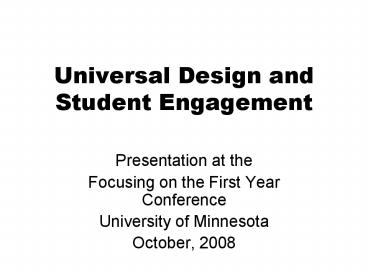Universal Design and Student Engagement PowerPoint PPT Presentation
1 / 24
Title: Universal Design and Student Engagement
1
Universal Design and Student Engagement
- Presentation at the
- Focusing on the First Year Conference
- University of Minnesota
- October, 2008
2
Presenter Contact Information
- Emily Goff, goff0009_at_umn.edu
- Jeanne L. Higbee, higbe002_at_umn.edu
- Ellyn Couillard, ln061484_at_yahoo.com
- http//www.cehd.umn.edu/passit
3
Agenda
- Uncertain Welcome Video Clip
- Defining Universal Design (UD) Universal
Instructional Design (UID) - UID In the Classroom
- UD in Student Services
- Scenarios (if time permits)
- Resources for Faculty and Staff
4
A Note About PowerPoint
- These slides are designed to be readable, rather
than pretty. Guidelines include - Sans-serif font, preferably 32-point, but minimum
28-point - Absence of artwork that distracts the reader and
does not add to content - Description of any photos, artwork, visuals,
charts, graphs, etc., that cannot be read by a
screen reader
5
Disclosure
- What can we learn from the video clip on
disclosure from Uncertain Welcome? - What can faculty and staff do to encourage
students with disabilities to disclose?
6
Definition of Universal Design
- Universal Design is the design of products and
environments to be usable by all people, to the
greatest extent possible, without the need for
adaptation or specialized design - Source The Center for Universal Design (1997)
7
Not just one size fits all . . .
- Applied to higher education, the primary goal of
Universal Design is to create inclusive,
flexible, customizable products, courses,
programs, activities, and environments.
8
Curb-Cuts
9
Description of Previous Visual
- The previous slide is a photograph of a street
corner with yellow painted curbs and white
striped crosswalks. At the crosswalks the
sidewalk and curbs are modified so that their
height descends to street level and that area is
unpainted.
10
Universal Instructional Design(UID)
- UID involves the highly intentional and
reflective practice of considering the multiple
and intersecting social identities of all
students who might potentially pursue an academic
program, enroll in a class, or use a learning
support service (e.g., learning center) when
designing the program, course, or service
11
UID Guiding Principles
- Create a welcoming and respectful learning
environment - Determine essential course components
- Communicate clear expectations
- Provide constructive feedback in a timely fashion
- Develop natural supports for learning, including
through use of technology (see Ch 34 Digital
Divide)
12
UID Principles (cont.)
- Use multiple teaching strategies
- Provide multiple types of opportunities to
demonstrate knowledge - Encourage contact between students and faculty
13
Benefits of UID for Students
- Eliminates need to be segregated for some
accommodations (e.g., time) - Addresses stigma associated with medical model
(disability as deficiency see Ch 2) - Recognizes individual differences among all
learners, including in learning styles ways of
knowing - Enables students to use their strengths to
demonstrate knowledge
14
What Are Essential Components?
- The outcomes (skills, knowledge, attitudes, and
habits of the mind) all students must
demonstrate with or without using accommodations
to be evaluated in a nondiscriminatory manner - Outcomes, not process (although in some courses
skill development requires learning in a specific
way)
15
Articulating essential components allows faculty
to
- treat all students fairly
- feel confident when making course modifications
for students who are ill or who have extreme
personal circumstances - determine reasonable accommodations for students
with disabilities
16
To determine essential components consider
- The purpose of the course
- Whether the course serves as a prerequisite for
subsequent course work - Outcomes absolutely required of all students in
the course, with or without accommodations - Instructional methods that most effectively
address the essential outcomes - Effective measures that allow fair evaluation of
all students
17
UD Principles for Student Development
Programs and Services(UDSD)
- Create welcoming spaces
- Develop pathways for communication
- Promote interaction among students and between
staff and students - Ensure equal opportunities for learning and
growth
18
UDSD Principles (cont.)
- Communicate clear expectations
- Use methods that consider diverse learning styles
- Provide natural supports
- Ensure confidentiality
- Define service quality
19
Examples of Implementing UD, UID, UDSD
- A prospective students first contact with the
institution may be via its Web sitewhat do we
need to know/do to be sure the site and its many
links are universally accessible and welcoming to
all? - How do we design a universally-accessible campus
tour?
20
Examples (cont.)
- How can an adviser ensure that every student
feels welcome and valued during the advising
process? - How do we conduct group interviews (e.g. for
residence hall staff or orientation leader
positions)? - How do we plan a stress reduction/ relaxation
training workshop?
21
Examples (cont.)
- What might we include in a checklist for planning
campus events and activities? - What would the syllabus for a universally-designed
first-year experience course look like? - How do we design universally accessible career
servicesincluding campus visits by employment
recruiters?
22
Questions to Consider
- Are you being explicit about the purpose of your
service or program? - Are you clear about the information/skills
students are expected to gain? - What are the concepts students need to master and
understand to engage in the process or service? - How do you measure the proficiency a student
needs to demonstrate information learned in the
service area?
23
Benefits of UD and UID
- Although UD and UID were originally envisioned to
provide access for people with disabilities, if
implemented intentionally to serve all
inhabitants/ learners/workers, everyone benefits - Just as everyone benefits from involvement in
diverse educational settings, everyone benefits
from making those settings more inclusive
(distinguishing between diversity
multiculturalism)
24
PASS IT
- U.S. Department of Education grant, 2005-2008,
P333A050023 - Focus on developing discipline-specific
professional development materials for teaching
and student services - Online resource bibliographies, legal resources,
book, professional development guidebooks video
forthcoming

